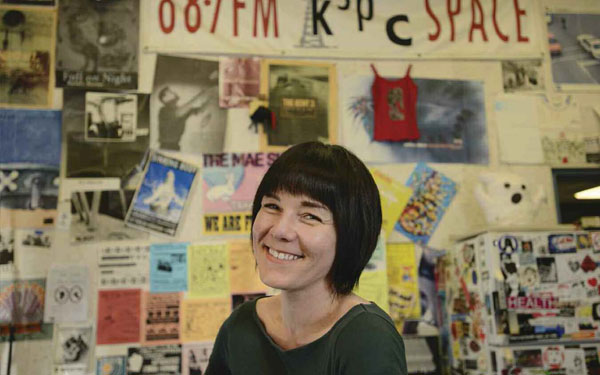
Long before KSPC Director Erica Tyron’s 25 years at the station, there was her turn as a DJ in the fourth grade. In a classroom overlooking the schoolyard, her teacher, Mr. Ramirez, set up a turntable and speaker, and allotted the kids 20-minute shifts to spin to their little hearts’ content. Tyron’s favorites to play included “Rock Lobster” by the B-52s and ABBA’s “Eagle,” a choice the young, diehard fan would immediately regret because it ran a full six minutes, cutting into her time.
That was back in the day—before music on demand—when every minute of airtime mattered. “Radio was everywhere,” recalls Tyron. “That was really your connection to what was happening in pop culture … it was a lifeline.”
Tyron held tight to that lifeline. During her four years as a Scripps student, the anthropology major took pretty much every position a student could hold at KSPC: publicity director, production director, management, newscaster. By the end of her first year she had a midnight-to-3 a.m. underground rock show, which later became “Stick It in Your Ear,” showcasing local bands live. She spent her summers at the station, too, and when she graduated in 1992 she was immediately hired as KSPC director. Day-to-day, Tyron, who also directs the Studio DJs, 120 volunteers and 18 student managers, to keep the FM station humming around the clock, every day of the year. It’s her dream job, Tyron says.
But today the role of radio has been changing in response to the rise of iTunes and digital streaming sites such as Pandora and Spotify. “Pre-Internet, the discovery of music was college radio,” Tyron says. “Once the Internet happened, that really changed things for a time. It was a transition of how students and people in general consume music.”
Where does that leave radio? Tyron says what initially seemed like a threat hasn’t really become one. “I think although there’s obviously a definite advantage to a Pandora service, or anything where you can create your own channels on demand and don’t have to worry about commercials, that’s obviously going to have a draw. But what [radio has] is the character and personality and local content,” she says.
People are always going to be hungry for news, and a station is a way to hear about events, even more so now that newspapers’ budgets and community coverage have been drastically cut, Tyron points out. And the digital revolution has actually extended radio’s reach: Today, KSPC can be heard anywhere on the globe via live stream.
The listeners are signaling their support, with more response and call-ins than KSPC (88.7 FM) has ever had before, Tyron says. In other words, Internet didn’t kill the radio star. “I think people don’t want to or don’t have time to line up all their playlists. Or maybe they just forgot their iPod that day. I think people still like to be surprised and L.A. is still very much a car culture. Off campus we’re picking up new listeners who are just cruising around the dial, looking for something else to listen to.”
